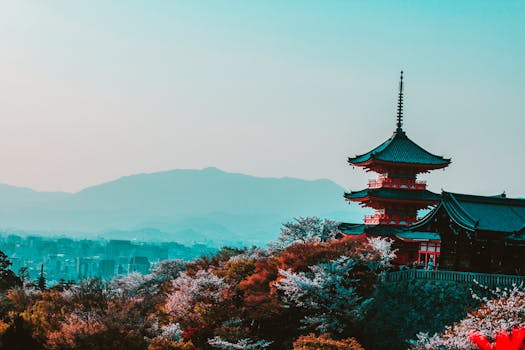Discover the Fascinating Culture of Japan by Visiting Kyoto’s Temples, Zen Gardens, and Medieval Castles
Kyoto, the ancient capital of Japan, is a city that beautifully encapsulates the rich cultural heritage of the country. Renowned for its stunning temples, serene Zen gardens, and majestic medieval castles, Kyoto offers visitors a unique glimpse into Japan’s past. This article explores the significance of these cultural landmarks and how they contribute to the understanding of Japanese culture.
The Spiritual Heart: Temples of Kyoto
Kyoto is home to over 1,600 Buddhist temples, each with its own unique history and architectural style. Among the most famous are:
- Kinkaku-ji (Golden Pavilion): This Zen temple is covered in gold leaf and surrounded by beautiful gardens, reflecting the harmony between nature and architecture.
- Ginkaku-ji (Silver Pavilion): Although it was never covered in silver, this temple is celebrated for its understated beauty and the exquisite moss garden that surrounds it.
- Ryoan-ji: Known for its rock garden, Ryoan-ji is a prime example of Zen aesthetics, inviting contemplation and meditation.
These temples not only serve as places of worship but also as cultural symbols. For instance, Kinkaku-ji was originally built as a retirement villa for shogun Ashikaga Yoshimitsu in the 14th century, showcasing the opulence of the Muromachi period. Today, it attracts over 1.5 million visitors annually, highlighting its significance in Japanese culture.
Zen Gardens: A Retreat into Tranquility
Zen gardens, or “karesansui,” are an integral part of Kyoto’s cultural landscape. These minimalist gardens are designed to promote meditation and reflection. The key features of Zen gardens include:
- Raked Gravel: Symbolizing water, the raked patterns in the gravel create a sense of movement and tranquility.
- Strategically Placed Rocks: Each rock represents islands or mountains, carefully positioned to evoke a sense of balance and harmony.
- Moss and Plants: The use of moss and other plants adds a touch of life and color, enhancing the overall aesthetic.
One of the most famous Zen gardens is at Ryoan-ji, where visitors can contemplate the arrangement of 15 rocks against a backdrop of raked gravel. The simplicity of these gardens encourages a deeper understanding of Zen philosophy, emphasizing the importance of mindfulness and presence.
Medieval Castles: A Glimpse into Feudal Japan
Kyoto’s medieval castles offer a fascinating insight into Japan’s feudal history. While many castles were destroyed during wars and natural disasters, a few remain as testaments to the architectural prowess of the time. Notable examples include:
- Nijo Castle: Built in 1603, this UNESCO World Heritage site features stunning gardens and intricate wooden architecture, showcasing the power of the Tokugawa shogunate.
- Fushimi Castle: Although reconstructed, this castle offers a glimpse into the strategic importance of castles during the Sengoku period.
Nijo Castle is particularly famous for its “nightingale floors,” which chirp when walked upon, designed to alert inhabitants of intruders. This innovative feature reflects the blend of functionality and artistry that characterizes Japanese architecture.
Experiencing Kyoto: Cultural Immersion
Visiting Kyoto is not just about seeing historical sites; it’s about immersing oneself in the culture. Here are some ways to enhance your experience:
- Participate in a Tea Ceremony: Engage in this traditional ritual that emphasizes harmony, respect, purity, and tranquility.
- Stay in a Ryokan: Experience traditional Japanese hospitality in a ryokan, where you can enjoy tatami-matted rooms and kaiseki meals.
- Attend a Festival: Kyoto hosts numerous festivals throughout the year, such as Gion Matsuri, which showcases traditional floats and performances.
These experiences allow visitors to connect with the local culture on a deeper level, fostering a greater appreciation for Japan’s rich heritage.
Conclusion: A Journey Through Time
Kyoto’s temples, Zen gardens, and medieval castles are not just tourist attractions; they are gateways to understanding the profound cultural heritage of Japan. Each site tells a story, reflecting the values, beliefs, and artistic expressions of the Japanese people. By exploring these landmarks, visitors can gain insights into the spiritual and historical significance that shapes modern Japan. Whether you are seeking tranquility in a Zen garden or marveling at the intricate designs of a temple, Kyoto offers a unique journey through time that is both enriching and unforgettable.
